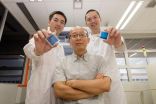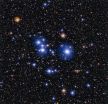(Press-News.org) The Atlantic Ocean at mid-depths may have given out early warning signals - 1,000 years in advance - that the last Ice Age was going to end, scientists report today in the journal Paleoceanography.
Scientists had previously known that at the end of the last Ice Age, around 14,700 years ago, major changes occurred to the Atlantic Ocean in a period known as the Bolling-Allerod interval. During this period, as glaciers melted and the Earth warmed, the currents of the Atlantic Ocean at its deepest levels changed direction.
The researchers have analysed the chemistry of 24 ancient coral fossils from the North Atlantic Ocean to learn more about the circulation of its waters during the last Ice Age. They found that the corals recorded a high variability in the currents of the Atlantic Ocean at mid-depths, around 2km below the surface, up to 1,000 years prior to the Bolling-Allerod interval. The team suggests that these changes may have been an early warning signal that the world was poised to switch from its glacial state to the warmer world we know today, and that the changes happened first at mid-depths.
The study was carried out by researchers from Imperial College London in conjunction with academics from the Scottish Marine Institute, the University of Bristol and Caltech Division of Geology and Planetary Sciences.
Dr David Wilson, from the Department of Earth Science and Engineering at Imperial College London, said: "The world's oceans have always been an important barometer when it comes to changes in our planet. Excitingly, the coral fossils we've studied are showing us that the North Atlantic Ocean at mid-depths was undergoing changes up to 1,000 years earlier than we had expected. The tantalising prospect is that this high variability may have been a signal that the last Ice Age was about to end."
The fossil corals analysed by the team come from a species called Desmophyllum dianthus, which are often around 5cm in diameter and look like budding flowers. They typically only live for 100 years, giving the team a rare insight into what was happening to the ocean's currents during this relatively brief time. Thousands of years ago they grew on the New England Seamounts, which are a chain of undersea mountains approximately 1000km off the east coast of the US, located at mid-depths 2km beneath the surface. This underwater area is important for understanding the North Atlantic's currents.
While some of the corals analysed by the team come from historical collections, most have been collected by researchers from previous expeditions in 2003 and 2005 to the New England Seamounts. The researchers used deep sea robotic submergence vehicles called Hercules and Alvin to collect the ancient coral fossils.
These ancient coral fossils accumulated rare earth elements from seawater, including neodymium, which leached from rocks on land into the Atlantic Ocean and circulated in its currents, eventually ending up in the coral skeletons. Neodymium isotopes in different regions of the world have specific signatures, created by radioactive decay over billions of years. The scientists studied the chemistry of the coral fossils to determine where the neodymium isotopes had come from, giving them a glimpse into the circulation of the Atlantic Ocean at the end of the Ice Age.
Since the world's oceans are connected by currents, the next step will see the team integrating the evidence they gathered from the North Atlantic Ocean into a picture of global changes in the mid-depths of oceans around the world. In particular, the team is interested in exploring how the Southern Ocean around Antarctica changed around the same time by analysing neodymium isotopes in a collection of Southern Ocean corals.
INFORMATION:
For further information please contact:
Colin Smith
Senior Research Media Officer
Communications and Public Affairs
Imperial College London
South Kensington Campus
London SW7 2AZ
Tel: +44 (0)20 7594 6712
Email: cd.smith@imperial.ac.uk
Duty press officer mobile: +44 (0)7803 886248
Notes to editors:
"Dynamic intermediate ocean circulation in the North Atlantic during the Heinrich Stadial 1: A radiocarbon and neodymium perspective" published in the journal Paleoceanography on 17 December 2014.
Download a copy of the paper: http://onlinelibrary.wiley.com/doi/10.1002/2014PA002674/pdf
David J. Wilson [1] , Kirsty C. Crocket [1,2], Tina van de Flierdt [1], Laura F. Robinson [3,4], and Jess F. Adkins [5] [1]DepartmentofEarthScience andEngineering, ImperialCollegeLondon,London,UK, [2]ScottishAssociationfor MarineScience, Scottish Marine Institute, Oban, UK, [3]School of Earth Sciences, University of Bristol, Bristol, UK, [4]Department of Marine, Chemistry and Geochemistry, Woods Hole Oceanographic Institution, Woods Hole, Massachusetts, USA, [5]Caltech Division of Geology and Planetary Sciences, MS 131-24, Pasadena, California, USA
About Imperial College London
Consistently rated amongst the world's best universities, Imperial College London is a science-based institution with a reputation for excellence in teaching and research that attracts 14,000 students and 6,000 staff of the highest international quality. Innovative research at the College explores the interface between science, medicine, engineering and business, delivering practical solutions that improve quality of life and the environment - underpinned by a dynamic enterprise culture.
Since its foundation in 1907, Imperial's contributions to society have included the discovery of penicillin, the development of holography and the foundations of fibre optics. This commitment to the application of research for the benefit of all continues today, with current focuses including interdisciplinary collaborations to improve global health, tackle climate change, develop sustainable sources of energy and address security challenges.
http://www.imperial.ac.uk
2013 saw global CO2 emissions from fossil fuel use and cement production reach a new all-time high. This was mainly due to the continuing steady increase in energy use in emerging economies over the past ten years. However, emissions increased at a notably slower rate (2%) than on average in the last ten years (3.8% per year since 2003, excluding the credit crunch years).
This slowdown, which began in 2012, signals a further decoupling of global emissions and economic growth, which reflects mainly the lower emissions growth rate of China. China, the USA and the EU remain ...
Mistletoe hanging in doorways announces that the holidays are just around the corner. For some people, however, the symbolic plant might one day represent more than a kiss at Christmas time: It may mean better liver health. Researchers have found that a compound produced by a particular variety of the plant can help fight obesity-related liver disease in mice. Their study appears in ACS' Journal of Agricultural and Food Chemistry.
Jungkee Kwon and colleagues note that, according to recent research, Korean mistletoe produces a number of biologically active compounds. These ...
Social media such as Twitter and Facebook can be valuable in the fight against HIV in the United States, where research has demonstrated they can prompt high-risk populations to request at-home testing kits for the virus that causes AIDS, suggesting a way to potentially boost testing rates.
But does it lead to actual testing, and can it work outside the United States? A new study from the UCLA Center for Digital Behavior published online Dec. 15 by the peer-reviewed journal Lancet HIV suggests that it can. The study, conducted in Peru among men who have sex with men, ...
MAYWOOD, Ill. - Although stroke is the No. 4 cause of death and a leading cause of disability in the United States, there's an increasing shortage of neurologists who specialize in stroke care.
In the December issue of the journal Stroke, two prominent neurologists propose a bold program to increase the number of stroke specialists. Their proposals include encouraging more young physicians to specialize in stroke, increasing stroke specialists' pay and opening the subspecialty to physicians who are not neurologists.
The authors are Harold P. Adams, Jr., MD of the University ...
(SACRAMENTO, Calif.) -- While the overall death rate from firearm violence has remained unchanged for more than a decade, the patterns for suicide and homicide have changed dramatically, a UC Davis study on the epidemiology of gun violence from 2003 to 2012 has found. The study posted online in the Annual Review of Public Health on Dec. 12 and will appear in the print edition in January.
"Suicide by firearm is far more common than homicide," said Garen J. Wintemute, professor of emergency medicine and director of the Violence Prevention Research Program at UC Davis. ...
Recent research at Griffith University has found that personality is more important than intelligence when it comes to success in education.
Dr Arthur Poropat from Griffith's School of Applied Psychology has conducted the largest ever reviews of personality and academic performance. He based these reviews on the fundamental personality factors (Conscientiousness, Openness, Agreeableness, Emotional Stability, and Extraversion) and found Conscientiousness and Openness have the biggest influence on academic success.
The results have been published in the journal Learning ...
Nanyang Technological University (NTU Singapore) scientists have developed a smart window which can darken or brighten without the need for an external power source.
This unique self-tinting window requires zero electricity to operate and is also a rechargeable battery. The window's stored energy can be used for other purposes, such as to light up low-powered electronics like a light emitting diode (LED).
Currently, the window solutions in the market are either using permanent tinting which cannot brighten at night or are windows that can change its light transmission ...
A team of biologists has identified a set of nerve cells in desert locusts that bring about 'gang-like' gregarious behaviour when they are forced into a crowd.
Dr Swidbert Ott from the University of Leicester's Department of Biology, working with Dr Steve Rogers at the University of Sydney, Australia, has published a study that reveals how newly identified nerve cells in locusts produce the neurochemical serotonin to initiate changes in their behaviour and lifestyle.
The findings demonstrate the importance of individual history for understanding how brain chemicals ...
Messier 47 is located approximately 1600 light-years from Earth, in the constellation of Puppis (the poop deck of the mythological ship Argo). It was first noticed some time before 1654 by Italian astronomer Giovanni Battista Hodierna and was later independently discovered by Charles Messier himself, who apparently had no knowledge of Hodierna's earlier observation.
Although it is bright and easy to see, Messier 47 is one of the least densely populated open clusters. Only around 50 stars are visible in a region about 12 light-years across, compared to other similar objects ...
Treating bacterial infections with antibiotics is becoming increasingly difficult as bacteria develop resistance not only to the antibiotics being used against them, but also to ones they have never encountered before. By analyzing genetic and phenotypic changes in antibiotic-resistant strains of E. coli, researchers at the RIKEN Quantitative Biology Center (QBiC) in Japan have revealed a common set of features that appear to be responsible for the development of resistance to several types of antibiotics.
The study published in Nature Communications shows that resistance ...


